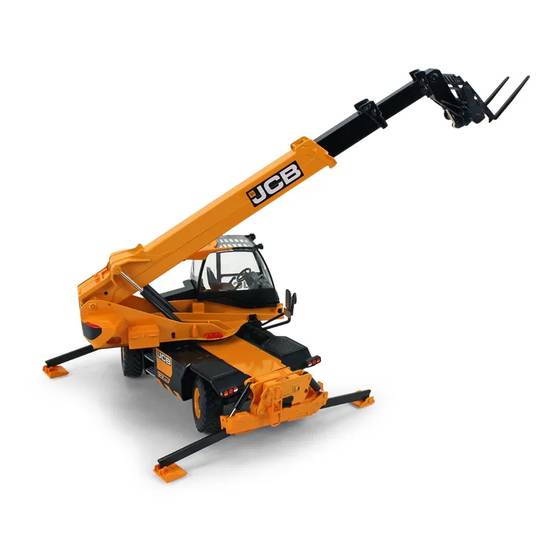
Table of Contents
Advertisement
Quick Links
Roto 512-83R
QUICK REFERENCE GUIDE
This Quick Reference Guide DOES NOT replace the Operators
Manual. You MUST read ALL the disclaimers and safety and other
instructions in the Operators Manual before initially operating this
product. Accordingly, no legal claims can be entertained based on
the data, illustrations or descriptions in this Quick Reference Guide.
Static Dimensions
Machine Model
Overall Height
A
Overall width over the tires
B
Front Track
C
Wheelbase
D
Overall length to front tires
E
Overall length to front carriage
F
Ground Clearance
G
Front wheel center to carriage
H
Rear wheel center to rear face
J
Rear tail swing
K
Inside width if cab (between windows)
L
M Outriggers fully extended (not deployed)
M Outriggers fully extended (Fully deployed)
Best Practices
1.
Carry a load as low as possible while maintaining good
visibility.
2.
Forks should be tilted back when in transport – with or
without a load, cradle the load.
3.
Fork tips should be on the ground when unit is parked.
4.
Rather than driving into the load, extend the boom to easier
see the forks in the load.
Cab Layout
512-83R
ft-in 10-1
ft-in
8-1
ft-in
6-8
ft-in 10-0
ft-in
17-4
ft-in
26-6
ft-in
1-1
ft-in 11-1
ft-in
5-5
ft-in 10-5
ft-in
A.
Instrument panel
3-1
B.
Multipurpose switch
ft-in 18-6
C.
Ignition switch
ft-in 17-4
D.
Console switches
E.
Heating and A/C controls
F.
Accelerator pedal
G.
Right hand joystick
H.
Outrigger control
J.
Switch panel
K.
Rotary switch control
L.
Slew lock lever
Tie Down Points
1.
Move the machine onto the transport vehicle.
2.
Engage the slew lock.
3.
Secure the machine to the trailer with chains. The chain angle must
be within the permissible angular range specified.
4.
The correct tie down positions are identified on the machine by
their labels.
5.
Measure the maximum height of the machine from the ground.
Instrument Panel
M.
Operator seat
N.
Left hand joystick
P.
Controls isolation lever
Q.
Brake pedal
R.
Transmission and drive lever
S.
Steering wheel
T.
Face level fan
U.
Load management system
Start Up Sequence
V.
Rapid recovery switch
A. Turn the key to position 1.
W.
Emergency recovery pump
B.
X.
LMS override
D. Display will ask for confirmation of the front attachment
E.
F.
G. Turn the key to start machine.
Access additional information
www.servicepro.jcb.com
A. Display screen
B.
Warning indicator
C. Tachometer
D. Navigation button down
E.
Navigation button up
F.
Fuel level gauge
G. Coolant temperature gauge
H. Information switch
A. Left front outrigger select
button
B.
Right front outrigger select
button
C. Left rear outrigger select
button
D. Right rear outrigger select
button
E.
Outriggers auto deploy and
level
F.
Outriggers auto stow
G.
Outriggers auto level select
button
H.
Axle oscillation lock button
J.
Sway left select button
K.
Sway right select button
L.
Control isolate button
M. Auto idle select button
Allow the machine display to start up.
Accept by pushing the check mark button (behind the
joystick)
Disarm the immobilizer by typing in the code and pressing
the check mark on the membrane pad.
Immobilizer keypad
Attachment Confirmation Switch
Advertisement
Table of Contents

Summary of Contents for jcb Roto 512-83R
- Page 1 Cab Layout Instrument Panel Roto 512-83R A. Display screen Warning indicator C. Tachometer QUICK REFERENCE GUIDE D. Navigation button down This Quick Reference Guide DOES NOT replace the Operators Navigation button up Manual. You MUST read ALL the disclaimers and safety and other...
- Page 2 Double Lever Control Chassis Levelling (Sway) Operation Battery Compartment Battery Cover Lock Hydraulic filler cap Carriage Tilt Forward Machine level indicator status Batteries Boom Raise Primary fuse Boom Lower Carriage Tilt Back Chassis level D. DEF tank filler cap Outrigger's level Boom Extend G.















Need help?
Do you have a question about the Roto 512-83R and is the answer not in the manual?
Questions and answers